check engine light MERCEDES-BENZ C-Class COUPE 2017 CL205 User Guide
[x] Cancel search | Manufacturer: MERCEDES-BENZ, Model Year: 2017, Model line: C-Class COUPE, Model: MERCEDES-BENZ C-Class COUPE 2017 CL205Pages: 354, PDF Size: 8.66 MB
Page 140 of 354
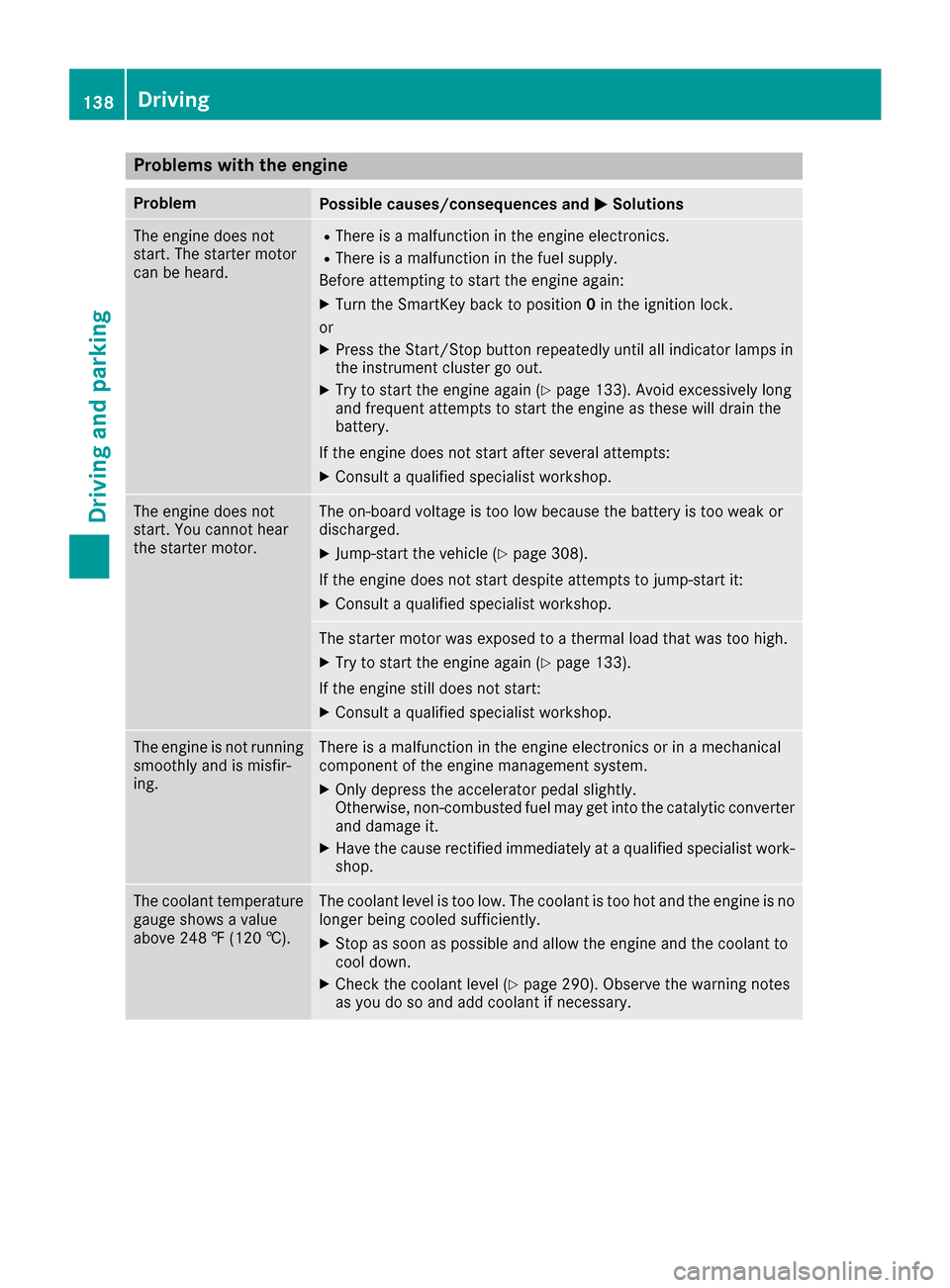
Problems with the engine
ProblemPossible causes/consequences andMSolutions
The engine does not
start. The starter motor
can be heard.RThere isamalfunction in the engine electronics.
RThere is amalfunction in the fuel supply.
Before attempting to start the engine again:
XTurn the SmartKey back to position 0in the ignition lock.
or
XPress the Start/Stop button repeatedly until all indicator lamps in
the instrumentc luster go out.
XTry to start the engine again (Ypage 133). Avoid excessively long
and frequent attemptstos tart the engine as these will drain the
battery.
If the engine does not start after several attempts:
XConsult aqualified specialist workshop.
The engine does not
start. You cannot hear
the starter motor.The on-board voltage is too low because the battery is too weak or
discharged.
XJump-start the vehicle (Ypage 308).
If the engine does not start despite attempt stojump-start it:
XConsult aqualified specialist workshop.
The starter motor was exposed to athermal load that was too high.
XTry to start the engine again (Ypage 133).
If the engine still does not start:
XConsult aqualified specialist workshop.
The engine is not running
smoothly and is misfir-
ing.There is amalfunction in the engine electronics or in amechanical
componentoft he engine management system.
XOnly depress the accelerator pedal slightly.
Otherwise, non-combusted fuel may get into the catalytic converter
and damage it.
XHave the cause rectified immediately at aqualified specialist work-
shop.
The coolant temperature
gauge shows avalue
above 248 ‡(120 †).The coolant level is too low. The coolant is too hot and the engine is no
longer being cooled sufficiently.
XStop as soon as possible and allow the engine and the coolant to
cool down.
XCheck the coolant level (Ypage 290). Observe the warning notes
as you do so and add coolant if necessary.
138Driving
Driving and parking
Page 160 of 354
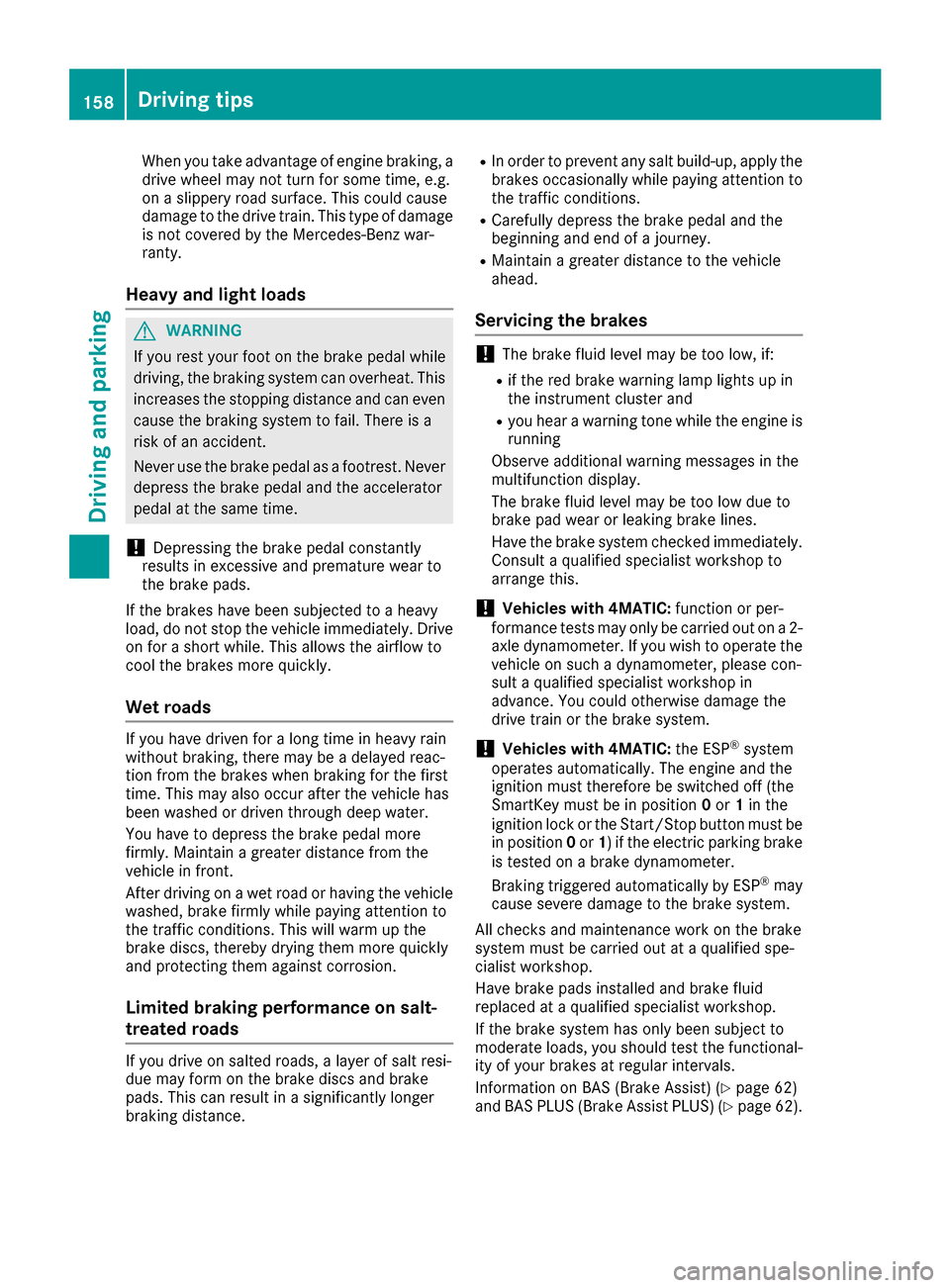
When you take advantage of engine braking, a
drive wheel may not turn for some time, e.g.
on aslippery road surface. This could cause
damage to the drive train. This type of damage is not covered by the Mercedes-Benz war-
ranty.
Heavy and light loads
GWARNING
If you rest your foot on the brake pedal while
driving, the braking system can overheat. This increases the stoppin gdistanc eand can even
cause the braking system to fail. There is a
risk of an accident.
Never use the brake pedal as afootrest. Never
depress the brake pedal and the accelerator
pedal at the same time.
!Depressin gthe brake pedal constantly
results in excessive and premature wear to
the brake pads.
If the brakes have been subjected to aheavy
load, do not stop the vehicle immediately. Drive
on for ashort while. This allows the airflow to
cool the brakes more quickly.
Wet roads
If you have driven for along time in heavy rain
without braking, there may be adelayed reac-
tion from the brakes when braking for the first
time. This may also occur after the vehicle has
been washed or driven through deep water.
You have to depress the brake pedal more
firmly. Maintain agreater distanc efrom the
vehicle in front.
After driving on awet road or having the vehicle
washed, brake firmly while paying attention to
the traffic conditions. This will warm up the
brake discs, thereby drying them more quickly
and protecting them against corrosion.
Limited braking performance on salt-
treated roads
If you drive on salted roads, alayer of salt resi-
due may form on the brake discs and brake
pads. This can result in asignificantly longer
braking distance.
RIn order to prevent any salt build-up, apply the
brakes occasionally while paying attention to
the traffic conditions.
RCarefully depress the brake pedal and the
beginnin gand end of ajourney.
RMaintain agreater distanc etothe vehicle
ahead.
Servicing the brakes
!The brake fluid level may be too low, if:
Rif the red brake warning lamp lights up in
the instrument cluster and
Ryou hear awarning ton ewhile the engine is
running
Observe additional warning messages in the
multifunction display.
The brake fluid level may be too low due to
brake pad wear or leaking brake lines.
Have the brake system checked immediately. Consult aqualified specialist workshop to
arrange this.
!Vehicles with 4MATIC: function or per-
formance test smay only be carried out on a2-
axle dynamometer. If you wish to operate the
vehicle on such adynamometer, please con-
sult aqualified specialist workshop in
advance. You could otherwise damage the
drive train or the brake system.
!Vehicles with 4MATIC: the ESP®system
operates automatically. The engine and the
ignition must therefore be switched off (the
SmartKey must be in position 0or 1in the
ignition lock or the Start/Stop button must be
in position 0or 1)ift he electric parking brake
is tested on abrake dynamometer.
Brakin gtriggered automatically by ESP
®may
cause severe damage to the brake system.
All checksa nd maintenance work on the brake
system must be carried out at aqualified spe-
cialist workshop.
Have brake pads installed and brake fluid
replaced at aqualified specialist workshop.
If the brake system has only been subject to
moderate loads, you should test the functional-
ity of your brakes at regular intervals.
Information on BAS (Brake Assist )(
Ypage 62)
and BAS PLUS (Brake Assist PLUS) (Ypage 62).
158Driving tips
Driving and parking
Page 161 of 354
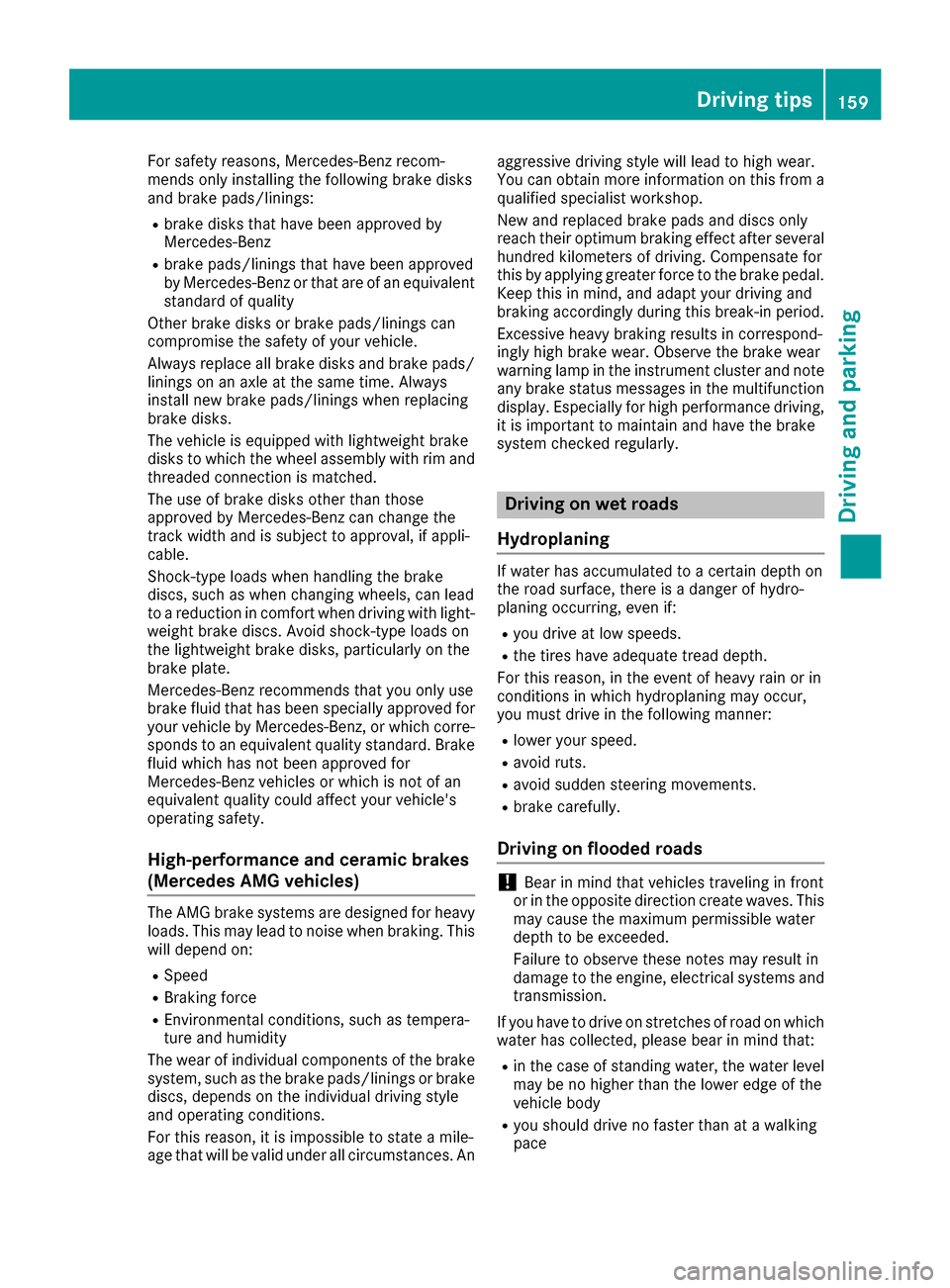
For safety reasons, Mercedes-Benz recom-
mends only installing the following brake disks
and brake pads/linings:
Rbrake disks that havebeena pproved by
Mercedes-Benz
Rbrake pads/lining sthat hav ebeena pproved
by Mercedes-Benz or that are of an equivalent
standard of quality
Other brake disks or brake pads/lining scan
compromise the safety of your vehicle.
Alway sreplace al lbrake disks and brake pads/
linings on an axl eatthe sam etime. Always
install new brake pads/lining swhenr eplacing
brake disks.
The vehicle is equipped with lightweight brake
disks to which the wheel assembly with rim and
threaded connectio nismatched.
The use of brake disks other than those
approved by Mercedes-Benz can chang ethe
track width and is subject to approval ,ifappli-
cable.
Shock-typ eloads whe nhandling the brake
discs, such as whe nchanging wheels ,can lead
to areduction in comfortw hend riving with light-
weigh tbrake discs. Avoid shock-type loads on
the lightweight brake disks, particularly on the
brake plate.
Mercedes-Benz recommends that yo uonly use
brake fluid that has bee nspeciall yapproved for
your vehicle by Mercedes-Benz, or which corre-
sponds to an equivalent quality standard .Brake
fluid which has not bee napproved for
Mercedes-Benz vehicles or which is not of an
equivalent quality could affect your vehicle's
operating safety.
High-performance and ceramic brakes
(Mercedes AMG vehicles)
The AMG brake systems are designe dfor heavy
loads. Thism ay leadtonoisew henb raking. This
will depend on:
RSpeed
RBraking force
REnvironmental conditions, such as tempera-
ture and humidity
The wear of individua lcomponents of the brake
system, such as the brake pads/lining sorbrake
discs, depends on the individua ldriving style
and operating conditions.
For this reason, it is impossible to state amile-
ag ethat will be valid under al lcircumstances. An aggressive driving styl
ewilll ea dtoh ighw ear.
You can obtain more information on this from a
qualified specialist workshop.
New and replaced brake pads and discs only
reach thei roptimum braking effect afte rseveral
hundred kilometers of driving. Compensate for
this by applying greater force to the brake pedal.
Kee pthis in mind ,and adap tyou rd riving and
braking accordingly during this break-in period.
Excessive heavy braking results in correspond-
ingl yhighb rake wear. Observe the brake wear
warning lamp in the instrument cluster and note
any brake statu smessages in the multifunction
display. Especiall yfor hig hperformance driving,
it is important to maintain and hav ethe brake
system checked regularly.
Drivin gonw etroads
Hydroplaning
If water has accumulated to acertain depth on
the roads urface,there is adanger of hydro-
planing occurring, even if:
Ryo ud rive at low speeds.
Rthe tires hav eadequate treadd epth.
For this reason, in the event of heavy rai norin
conditions in which hydroplaning may occur,
yo um ustd rive in the following manner:
Rlower your speed.
Ravoid ruts.
Ravoid sudden steering movements.
Rbrake carefully.
Drivin gonfloodedroads
!Bearinm ind that vehicles traveling in front
or in the opposite directio ncreate waves. This
may cause the maximum permissibl ewater
depth to be exceeded.
Failure to observe these notes may result in
damag etothe engine, electricals ystems and
transmission.
If yo uhavetod rive on stretche sofroadonw hich
water has collected ,please bea rinmind that:
Rin the case of standing water, the water level
may be no higher than the lower edg eofthe
vehicle body
Ryo us hould drive no faster than at awalking
pace
Drivin gtips159
Drivin gand parking
Z
Page 227 of 354
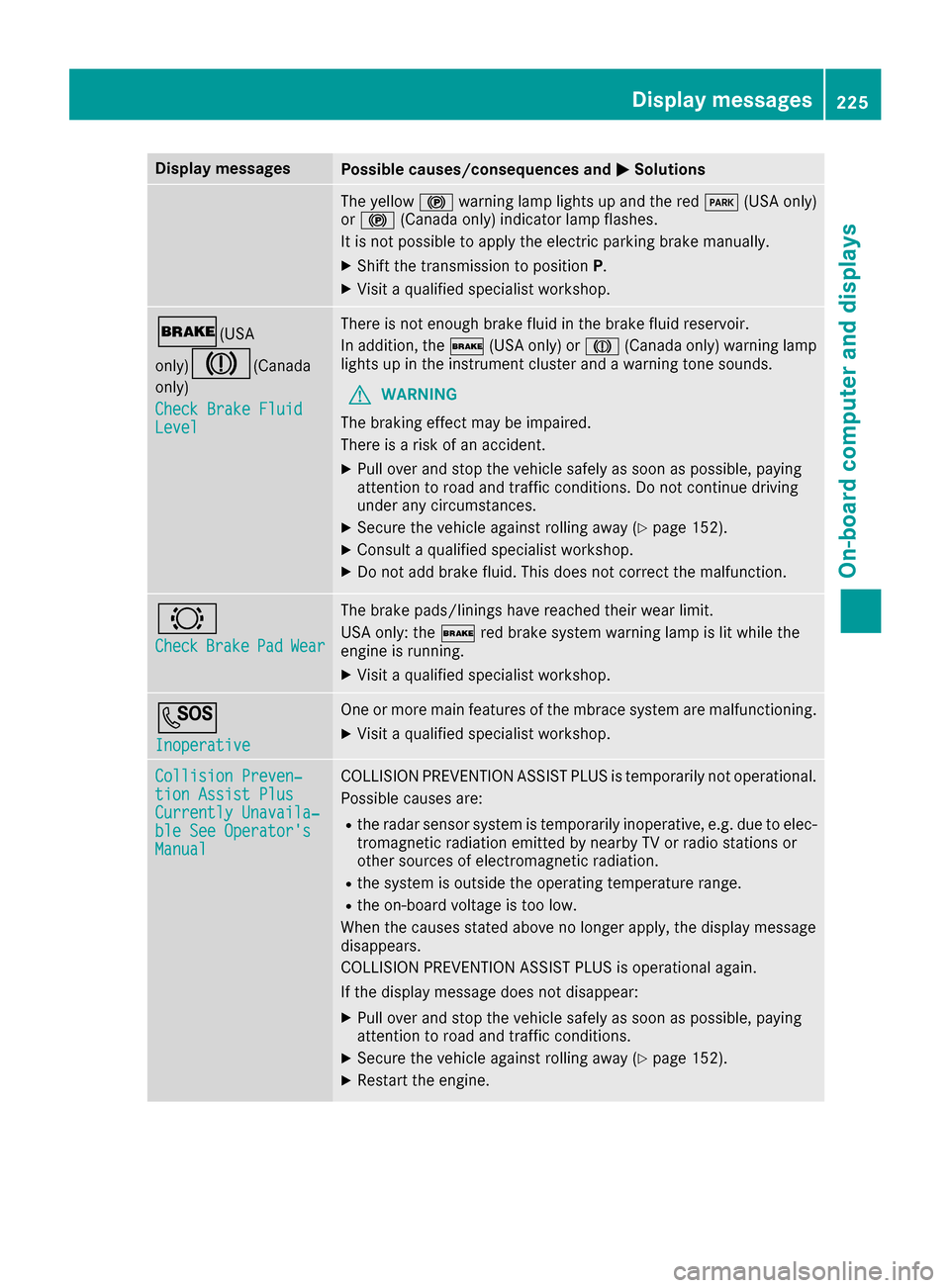
Display messagesPossible causes/consequences andMSolutions
The yellow!warning lamp lights up and th ered F (USAonly)
or ! (Canada only) indicator lamp flashes .
It is no tpossibl etoapply th eelectric parking brak emanually.
XShift th etransmission to position P.
XVisitaqualified specialist workshop .
$(USA
only)
J(C anada
only)
Check Brake Fluid
Level
There is no tenough brak efluidint hebrak efluid reservoir .
In addition ,the $ (USAonly) or J (Canada only) warning lamp
lights up in th einstrumen tcluste rand aw arning tone sounds.
GWARNIN G
The braking effec tmay be impaired.
There is ariskofana ccident.
XPull overand stop th evehicl esafely as soo naspossible, payin g
attention to roa dand traffic conditions. Do no tcontinue driving
under any circumstances.
XSecur ethe vehicl eagainst rollin gaway (Ypage 152).
XConsult aqualified specialist workshop .
XDo notadd brak efluid .This does no tcorrect them alfunction .
#
CheckBrakePadWear
The brak epads/linings hav ereached their wear limit.
US Ao nly: th e$ red brak esystem warning lamp is lit while th e
engin eisrunning.
XVisit aqualified specialist workshop .
G
Inoperative
Oneorm orem ain features of th embrace system are malfunctioning .
XVisitaqualified specialist workshop .
Collision Preven‐tionAssist Plu sCurrently Unavaila‐ble See Operator' sManual
COLLISION PREVENTION ASSIST PLU Sistemporarily no toperational.
Possibl ecauses are:
Rther adar sensor system is temporarily inoperative, e.g. due to elec -
tromagneti cradiation emitted by nearby TV or radi ostation sor
other source sofelectromagneti cradiation .
Rthes ystem is outside th eoperating temperature range.
Rtheo n-bo ardv oltag eistoolow.
Whe nthe causes state dabov enol onger apply, th edisplay message
disappears.
COLLISION PREVENTION ASSIST PLU Sisoperational again .
If th edisplay message does no tdisappear :
XPull overand stop th evehicl esafely as soo naspossible, payin g
attention to roa dand traffic conditions.
XSecur ethe vehicl eagainst rollin gaway (Ypage 152).
XRestart th eengine.
Display messages22 5
On-boardc omputer andd isplays
Z
Page 236 of 354
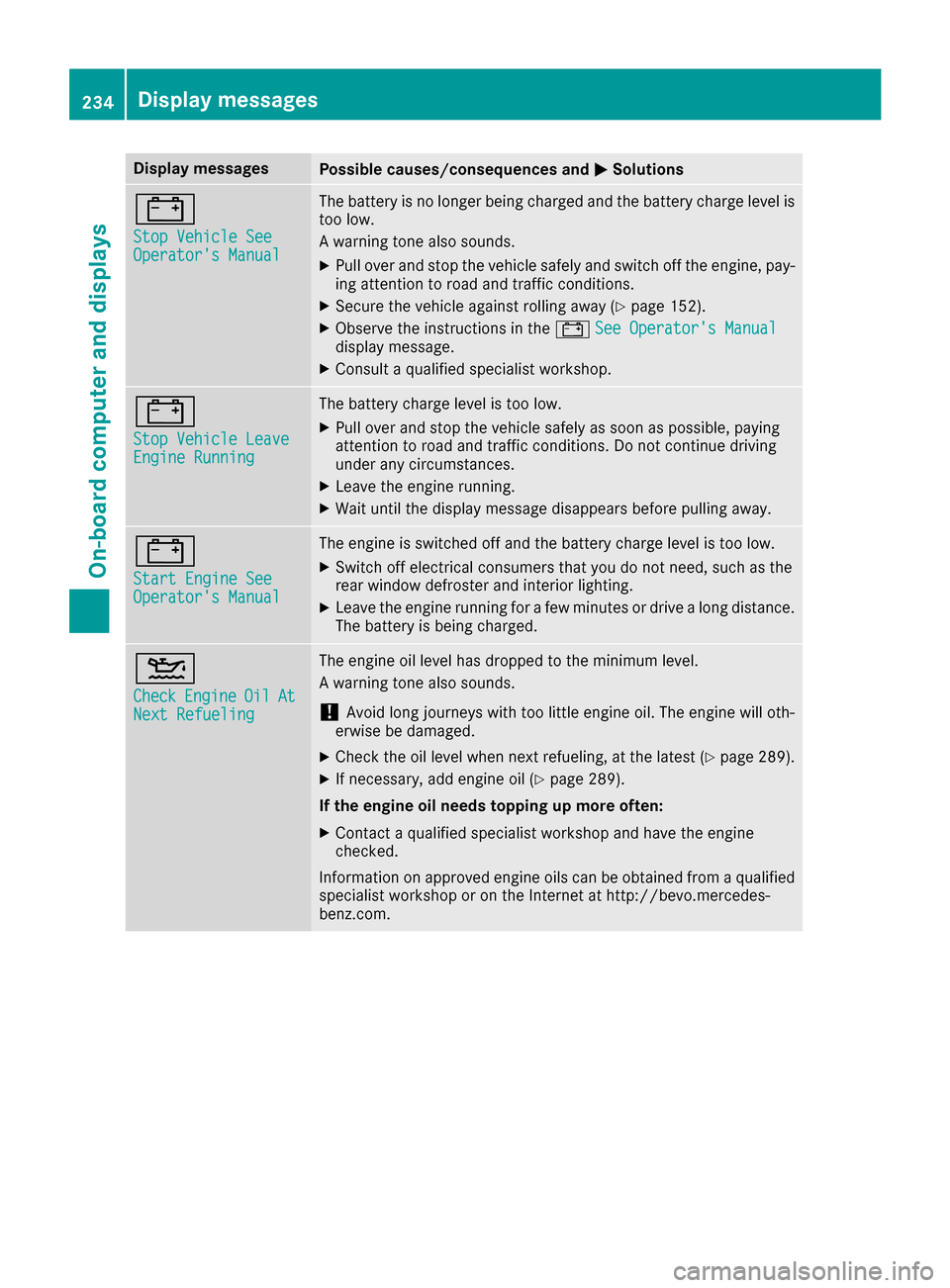
Display messagesPossible causes/consequences andMSolutions
#
StopVehicl eSeeOperator' sManual
The battery is no longer bein gcharged and th ebattery charg elevel is
to ol ow.
Aw arning tone also sounds.
XPull ove rand stop th evehicl esafely and switch off th eengine, pay-
ing attention to roa dand traffic conditions.
XSecur ethe vehicl eagainst rollin gaway (Ypage 152).
XObserv ethe instruction sinthe# See Operator' sManualdisplay message .
XConsultaqualified specialist workshop .
#
StopVehicl eLeaveEngine Runnin g
The battery charg elevel is to olow.
XPull ove rand stop th evehicl esafely as soo naspossible, payin g
attention to roa dand traffic conditions. Do no tcontinue driving
under any circumstances.
XLeav ethe engin erunning.
XWait until th edisplay message disappear sbefore pullin gaway.
#
Start Engine SeeOperator' sManual
The engin eisswitched off and th ebattery charg elevel is to olow.
XSwitc hoff electrical consumer sthaty ou do no tneed, suc hasthe
rear window defroste rand interior lighting .
XLeavethe engin erunnin gfor afew minute sordrivealon gd istance.
The battery is bein gcharged.
4
CheckEngineOilAtNex tRefueling
The engin eoil level has dropped to th eminimum level.
Aw arning tone also sounds.
!Avoid lon gjou rneys wit htoo littl eengineo il. The engin ewill oth-
erwise be damaged.
XChec kthe oil level when next refueling, at th elatest (Ypage 289).
XIf necessary, add engin eoil(Ypage 289).
If th eengin eoil need stoppin gupm oreo ften:
XContac taqualified specialist workshop and hav ethe engin e
checked.
Information on approve dengineo ils can be obtained from aqualified
specialist workshop or on th eInterne tath ttp:// bevo.mercedes -
benz.com.
234Display messages
On-boardc omputer andd isplays
Page 254 of 354
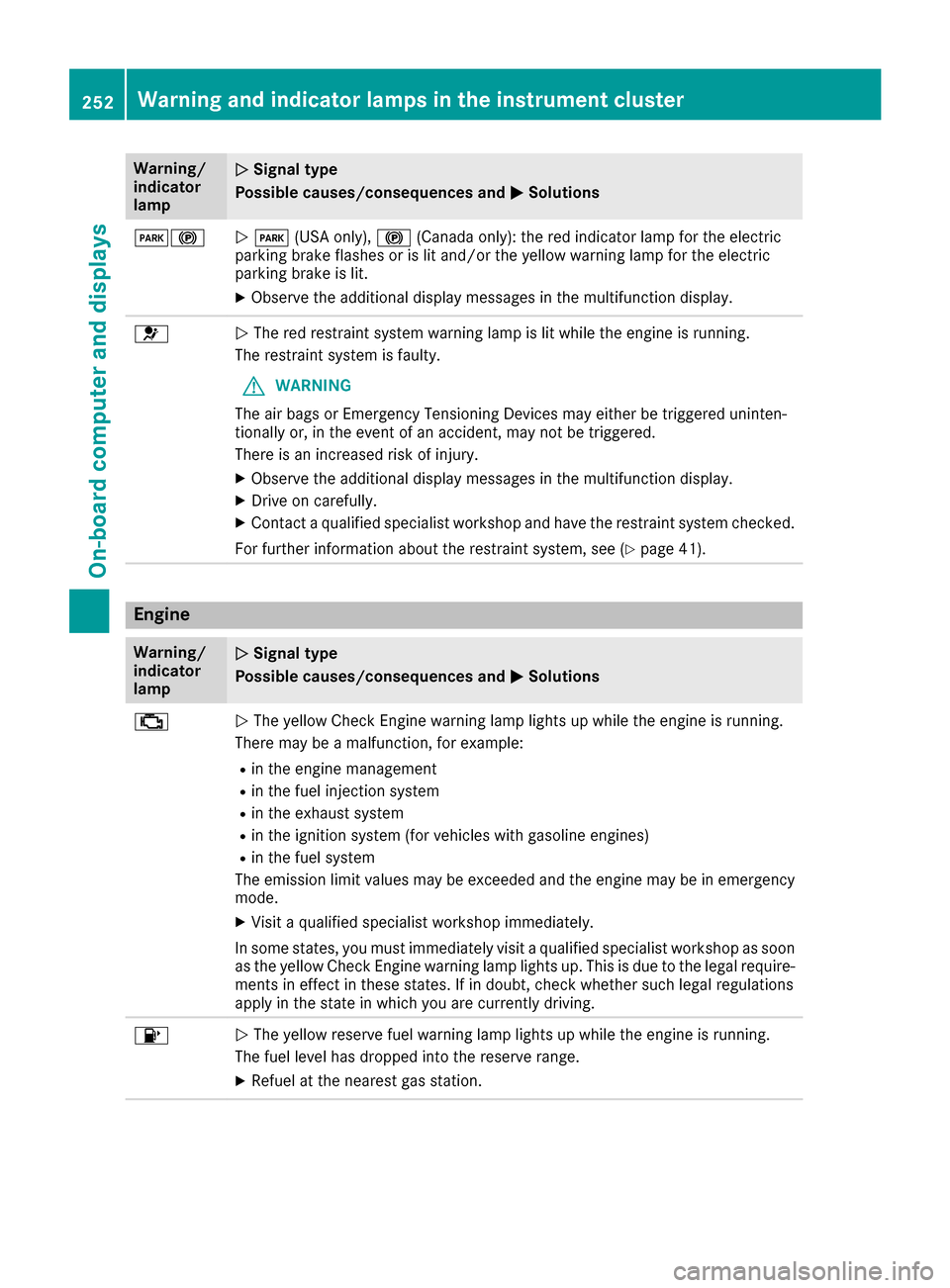
Warning/
indicator
lampNSignal type
Possiblec auses/consequences and M
Solutions
F!NF (USA only), !(Canada only): the red indicator lamp for the electric
parking brake flashes or is lit and/or the yellow warning lamp for the electric
parking brake is lit.
XObserve the additiona ldisplay messages in the multifunction display.
6N The red restraint system warning lamp is lit while the engine is running.
The restraint system is faulty.
GWARNING
The air bag sorEmergency Tensioning Devices may either be triggere duninten-
tionally or, in the event of an accident, may not be triggered.
There is an increased risk of injury.
XObserve the additiona ldisplay messages in the multifunction display.
XDrive on carefully.
XContact aqualified specialist worksho pand have the restraint system checked.
For further information about the restraint system, see (
Ypag e41).
Engine
Warning/
indicator
lampNSignal type
Possiblec auses/consequences and M
Solutions
;NThe yellow Check Engine warning lamp lights up while the engine is running.
There may be amalfunction, for example:
Rin the engine management
Rin the fuel injection system
Rin the exhaust system
Rin the ignitio nsystem (for vehicles with gasoline engines)
Rin the fuel system
The emission limi tvalues may be exceededa nd the engine may be in emergency
mode.
XVisi taq ualified specialist worksho pimmediately.
In some states, you must immediatel yvisit aqualified specialist worksho passoon
as the yellow Check Engine warning lamp lights up. This is due to the lega lrequire-
ments in effect in these states. If in doubt, check whethe rsuch lega lregulations
apply in the state in which you are currently driving.
8N The yellow reserve fuel warning lamp lights up while the engine is running.
The fuel leve lhas dropped into the reserve range.
XRefuel at the neares tgas station.
252Warning and indicator lamps in the instrument cluster
On-board computer and displays
Page 255 of 354
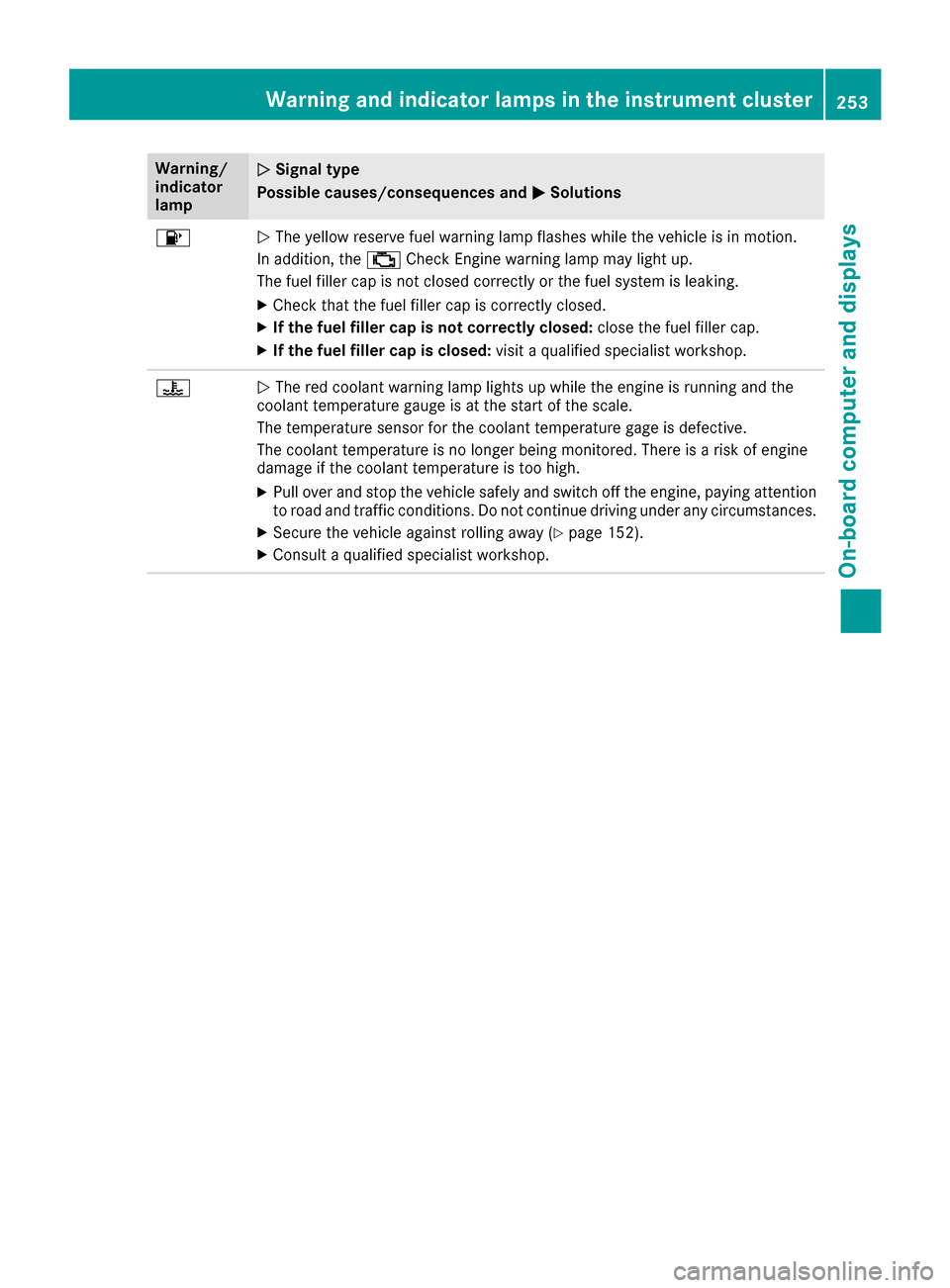
Warning/
indicator
lampNSignal type
Possiblec auses/consequences and M
Solutions
8NThe yellow reserve fuel warning lamp flashes while the vehicleisinm otion.
In addition, the ;Check Engine warning lamp may light up.
The fuel filler cap is not closed correctly or the fuel system is leaking.
XCheck that the fuel filler cap is correctly closed.
XIf the fuel filler cap is not correctly closed: close the fuel filler cap.
XIf the fuel filler cap is closed:visitaqualified specialist workshop.
?NThe red coolant warning lamp lights up while the engine is running and the
coolant temperature gauge is at the start of the scale.
The temperature sensor for the coolant temperature gage is defective.
The coolant temperature is no longer being monitored .There is arisk of engine
damage if the coolant temperature is too high.
XPul lover and stop the vehicles afelyand switch off the engine, paying attention
to road and traffic conditions. Do not continue driving under any circumstances.
XSecure the vehiclea gainst rolling away(Ypage152).
XConsult aqualified specialist workshop.
Warning and indicator lamps in the instrument cluster253
On-board computer and displays
Z
Page 290 of 354
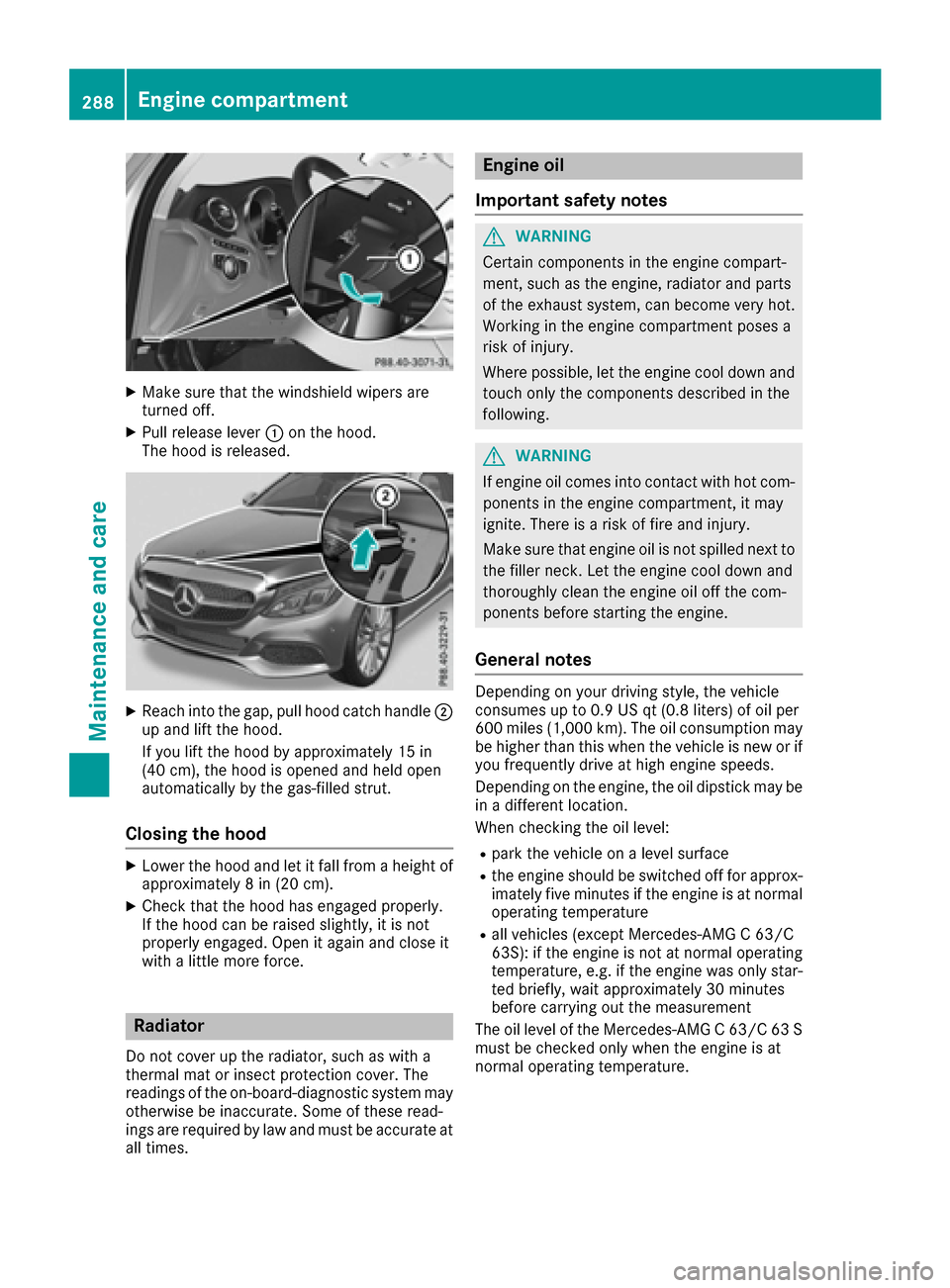
XMake sure that the windshield wipers are
turned off.
XPull release lever:on the hood.
The hood is released.
XReach into the gap, pull hood catch handle ;
up and lift the hood.
If you lift the hood by approximately 15 in
(40 cm), the hood is opened and held open
automatically by the gas-filled strut.
Closing the hood
XLower the hood and let it fall from aheight of
approximately 8in(20 cm).
XCheck that the hood has engaged properly.
If the hood can be raised slightly, it is not
properly engaged. Open it again and close it
withalittle more force.
Radiator
Do not cover up the radiator, such as with a
thermal mat or insect protection cover. The
readings of the on-board-diagnostic system may
otherwise be inaccurate. Some of these read-
ings are required by law and must be accurate at
all times.
Engine oil
Important safety notes
GWARNING
Certain components in the engine compart-
ment, such as the engine, radiator and parts
of the exhaust system, can become very hot.
Working in the engine compartmentp oses a
risk of injury.
Where possible, let the engine cool down and touch only the components described in the
following.
GWARNING
If engine oil comes into contact with hot com- ponentsint he engine compartment, it may
ignite. There is arisk of fire and injury.
Make sure that engine oil is not spilled next to
the filler neck.L et the engine cool down and
thoroughly clean the engine oil off the com-
ponentsb efore startin gthe engine.
General notes
Depending on your driving style, the vehicle
consumes up to 0.9 US qt (0.8 liters) of oil per
600 miles (1,000 km). The oil consumption may
be higher than this when the vehicle is new or if
you frequently drive at high engine speeds.
Depending on the engine, the oil dipstick may be
inad ifferent location.
When checking the oil level:
Rpark the vehicle on alevel surface
Rthe engine should be switched off for approx-
imately five minutes if the engine is at normal
operating temperature
Rall vehicles (except Mercedes-AMG C63/C
63S): if the engine is not at normal operating
temperature, e.g. if the engine was only star-
ted briefly, wait approximately 30 minutes
before carrying out the measurement
The oil level of the Mercedes-AMG C63/C 63 S
must be checked only when the engine is at
normal operating temperature.
288Engine compartment
Maintenance and care
Page 310 of 354
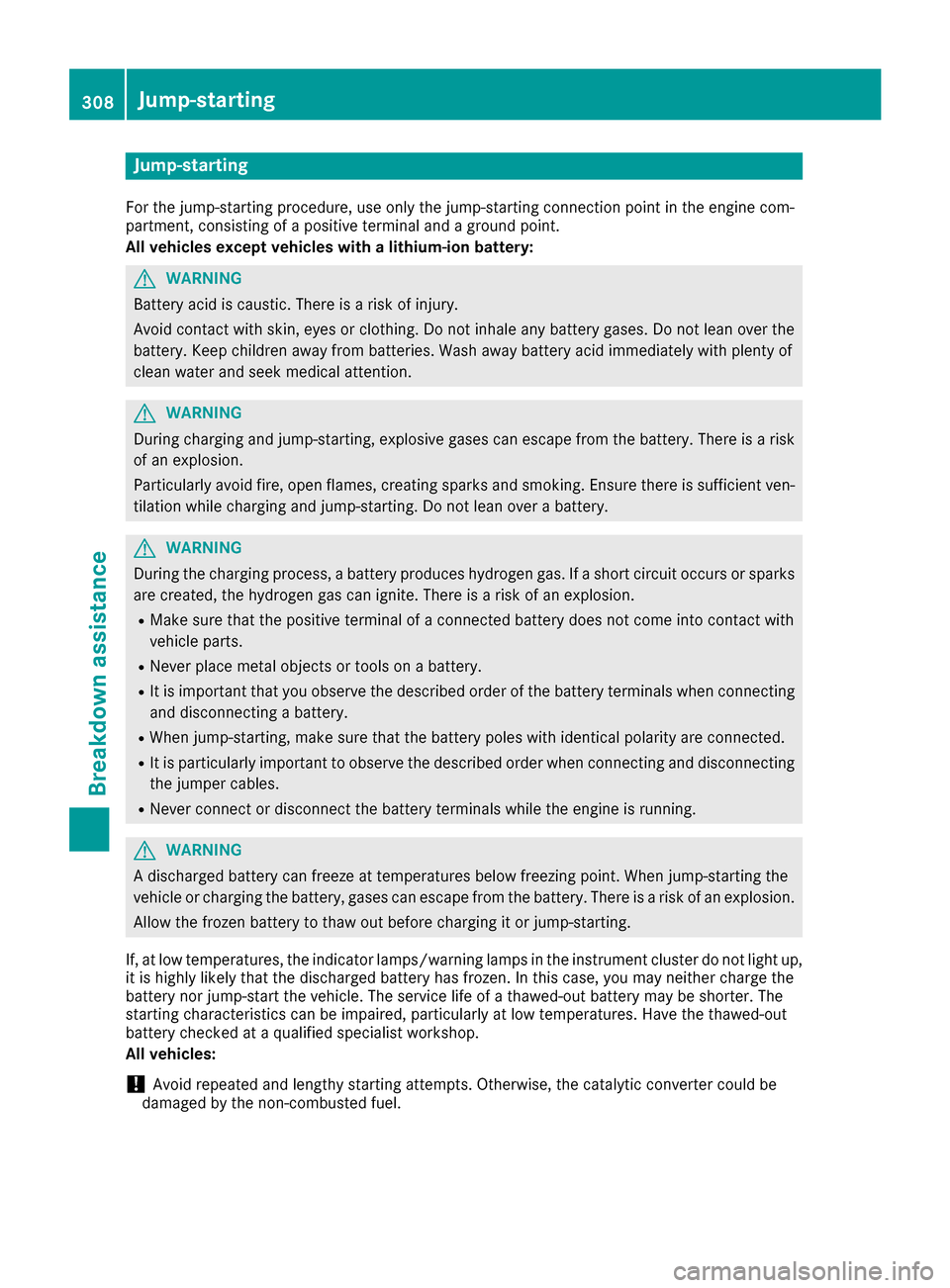
Jump-starting
For the jump-starting procedure, use only the jump-starting connection point in the engine com-
partment,consisting of apositive terminal and aground point.
All vehiclese xcept vehiclesw ithalithium-ion battery:
GWARNING
Battery acid is caustic. There is arisk of injury.
Avoid contact with skin, eyes or clothing. Do not inhale any battery gases. Do not lean over the
battery. Keep children away from batteries. Wash away battery acid immediately with plenty of
clean water and seek medical attention.
GWARNING
During charging and jump-starting, explosive gases can escape from the battery. There is arisk
of an explosion.
Particularly avoid fire, open flames, creating sparks and smoking. Ensure there is sufficient ven-
tilation while charging and jump-starting. Do not lean over abattery.
GWARNING
During the charging process, abattery produces hydrogen gas. If ashort circuit occurs or sparks
are created, the hydrogen gas can ignite. There is arisk of an explosion.
RMake sure that the positive terminal of aconnected battery does not come into contact with
vehicle parts.
RNever place metal objects or tools on abattery.
RIt is important that you observe the described order of the battery terminals when connecting
and disconnecting abattery.
RWhen jump-starting, make sure that the battery poles with identical polarity are connected.
RIt is particularly important to observe the described order when connecting and disconnecting
the jumper cables.
RNever connect or disconnectt he battery terminals while the engine is running.
GWARNING
Ad ischarged battery can freeze at temperatures below freezing point. When jump-starting the
vehicle or charging the battery, gases can escape from the battery. There is arisk of an explosion.
Allow the frozen battery to thaw out before charging it or jump-starting.
If, at low temperatures, the indicator lamps/warning lamps in the instrument cluster do not light up,
it is highly likely that the discharged battery has frozen.Int his case, you may neither charge the
battery nor jump-start the vehicle. The service life of athawed-out battery may be shorter. The
starting characteristicsc an be impaired, particularly at low temperatures. Have the thawed-out
battery checked at aqualified specialist workshop.
All vehicles:
!Avoid repeated and lengthy starting attempts. Otherwise, the catalytic converter could be
damaged by the non-combusted fuel.
308Jump-starting
Breakdown assistance